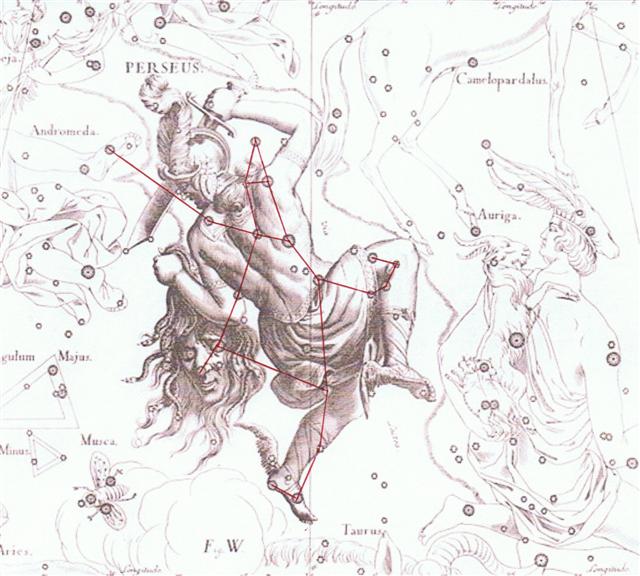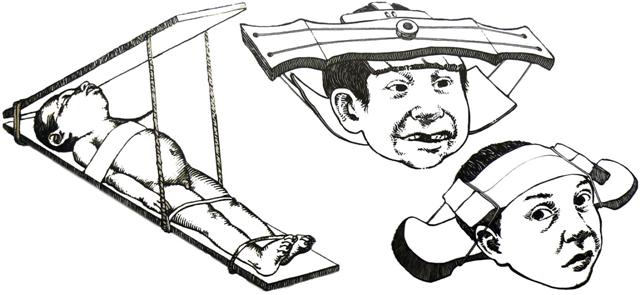Once again. The First Point of Aries (0h at the time of Julius Caesar) was supported at the back side by Polaris, which was rising with the Sun at the end of the previous equinoctial year, in day *364:
The First Point of Perseus was Alseiph (φ), at the right foot of Andromeda - which is quite remarkable. And Gb4-5 is equipped with female breasts.
Heliacal Sheratan ('March 21 = April 17 = FEBRUARY 12) ought to - I think - have belonged in the Foundation of our current cosmic diagram (creation). But, we should remember, the Gregorian 'canoe' was 'crooked'. His calendar was not in perfect alignment with the ancient star structure. Because he had avoided to adjust with the effects of the precession from the creation of the Julian calendar to the Council of Niceae in 325 A.D. Therefore the stars evidently occupied positions which were 3 days later in his calendar than in the Julian calendar. This meant that for instance Polaris had risen with the Sun not in FEBRUARI 11 but in *FEBRUARY 8. I am here forced to introduce a new notation in form of an asterisk (*) to indicate the correct star date according to the Julian structure. In FEBRUARY 11 (Gregorian calendar) = *FEBRUARY 8 (Julian calendar) the Sun had risen together with stars (e.g. Polaris) which at the time of rongorongo rose heliacally in *April 13 (4-13 as in 14 * 29½) = April 16:
To avoid confusion I will, however, normally keep to my earlier assumptions with the dates according to the crooked Gregorian calendar, although adjusted with the effects of the precession from (or to) the time of Gregory XIII. For instance have I not in my table above added such possible star dates as *şApril 7, *'March 15, or *"March 1. It is enough to keep these 3 'missing runes' in the Gregorian calendar in the memory banks at the back of our heads.
... Vainamoinen set about building a boat, but when it came to the prow and the stern, he found he needed three words in his rune that he did not know, however he sought for them. In vain he looked on the heads of the swallows, on the necks of the swans, on the backs of the geese, under the tongues of the reindeer. He found a number of words, but not those he needed. Then he thought of seeking them in the realm of Death, Tuonela, but in vain. He escaped back to the world of the living only thanks to his potent magic. He was still missing his three runes. He was then told by a shepherd to search in the mouth of Antero Vipunen, the giant ogre. The road, he was told, went over swords and sharpened axes. Ilmarinen made shoes, shirt and gloves of iron for him, but warned him that he would find the great Vipunen dead. Nevertheless, the hero went. The giant lay underground, and trees grew over his head. Vainamoinen found his way to the giant's mouth, and planted his iron staff in it. The giant awoke and suddenly opened his huge mouth. Vainamoinen slipped into it and was swallowed. As soon as he reached the enormous stomach, he thought of getting out. He built himself a raft and floated on it up and down inside the giant. The giant felt tickled and told him in many and no uncertain words where he might go, but he did not yield any runes. Then Vainamoinen built a smithy and began to hammer his iron on an anvil, torturing the entrails of Vipunen, who howled out magic songs to curse him away. But Vainamoinen said, thank you, he was very comfortable and would not go unless he got the secret words. Then Vipunen at last unlocked the treasure of his powerful runes. Many days and nights he sang, and the sun and the moon and the waves of the sea and the waterfalls stood still to hear him. Vainamoinen treasured them all and finally agreed to come out. Vipunen opened his great jaws, and the hero issued forth to go and build his boat at last ... |





